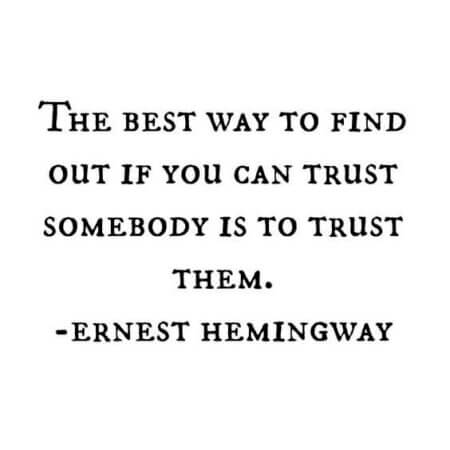
Positive asymmetry is another way to talk about creating an environment where you can “gain advantage”, by creating a situation where you have much more upside opportunity than downside risk. The easiest way to do this that I have seen (and seen over and over) is to choose to trust people.
My choice in life is to start from the position that all people are intrinsically good, to choose to trust others. I operate as a “high trust” person. Sure, once in a while this can cause problems, but my lifelong experience has shown me the opposite to be true. Choosing to trust has always been a source of “positive asymmetry” for me.
So, for more on this from others.
First, in 2019 I wrote: “The best way to find out if you can trust somebody is to trust them“, a line from Hemingway, but inspired by James Timpson, an inspirational business leader who, among other things, is one of the largest employers of ex-offenders in the UK, with many of those staff running one person key-cutting booths and handling cash and the responsibility for the whole outlet. The easiest way to create a culture of kindness in an organisation is to trust everyone to do what they think is right…every time a decision needs to be made. No trust equals high colleague turnover, poor sales and lower profits.
— James Timpson (@JamesTCobbler) October 9, 2018
In that same article, I went on to quote Patience Wheatcroft then also referred back to the first business book I ever read (and still love!), “Moments of Truth” by Jan Carlzon.
I’m inspired to write about trust again today by this “Tiny Thought” (his title for it) on Positive Asymmetry and Trust from Shane Parrish.
Linear games are won by working harder than others. And the harder other people work, the higher the bar. You need to work harder and harder, just to stay in the same relative position. Asymmetry is different. Even people who understand asymmetry consistently underestimate its power.
Positive asymmetry happens when you have a lot of upside and little downside. Negative asymmetry is when you have little upside and high downside. Finding hidden or overlooked asymmetry is the key to an unstoppable advantage. And there is a lot of it hiding in plain sight.
Consider trust. In a recent meeting, someone told me they wanted to move slowly because they’re slow to trust. Their default level of trust is about 40%. Very few people understand that a low trust approach reduces positive asymmetry.
Most of the time people deserve to be trusted by default. Perhaps 3% of the time they take advantage of you, and you make you look foolish. In an effort to avoid this 3% loss people will forgo asymmetric upside. Not only does a low trust approach eliminate the upside, but you spend your time looking over your shoulder worrying about how someone might take advantage of you.
High trust people want to be around other high trust people. I’m trustworthy by default. And while some people have taken advantage of me, I still prefer my approach because there is no ceiling on what’s possible. The three largest business deals of my life have all been high-trust deals. A low trust approach might put a floor on how often you get taken advantage of, but it puts a ceiling on what’s possible.
Shane Parrish – taken from his enewsletter, March 6th 2022. View in full and sign up for his weekly thoughts here
So, what is your approach to trust? How “high trust” are you?
